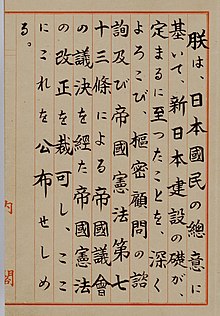
Back دستور اليابان Arabic জাপানৰ সংবিধান Assamese Yaponiya konstitusiyası Azerbaijani Канстытуцыя Японіі Byelorussian Японой Үндэһэн Хуули BXR Constitució del Japó Catalan دەستووری ژاپۆن CKB Verfassung des Staates Japan German Σύνταγμα της Ιαπωνίας Greek Konstitucio de Japanio Esperanto
| Constitution of Japan | |
|---|---|
 Preamble of the Constitution | |
| Overview | |
| Original title | 日本国憲法 |
| Jurisdiction | Japan |
| Presented | 3 November 1946 |
| Date effective | 3 May 1947 |
| System | Unitary parliamentary constitutional monarchy[1] |
| Government structure | |
| Branches | Three |
| Head of state | None[a] |
| Chambers | Bicameral (National Diet: House of Representatives, House of Councillors) |
| Executive | Cabinet, led by a Prime Minister |
| Judiciary | Supreme Court |
| Federalism | Unitary |
| History | |
| First legislature | |
| First executive | 24 May 1947 |
| First court | 4 August 1947 |
| Amendments | 0[3] |
| Location | National Archives of Japan |
| Author(s) | Milo Rowell, Courtney Whitney, and other US military lawyers working for the US-led Allied GHQ; subsequently reviewed and modified by members of the Imperial Diet |
| Signatories | Emperor Shōwa |
| Supersedes | Meiji Constitution |
| Full text | |
| This article is part of a series on |
 |
|---|
|
|
The Constitution of Japan[b] is the supreme law of Japan. Written primarily by American civilian officials during the occupation of Japan after World War II, it was adopted on 3 November 1946 and came into effect on 3 May 1947, succeeding the Meiji Constitution of 1889.[4] The constitution consists of a preamble and 103 articles grouped into 11 chapters. It is based on the principles of popular sovereignty, with the Emperor of Japan as the symbol of the state; pacifism and the renunciation of war; and individual rights.
Upon the surrender of Japan at the end of the war in 1945, Japan was occupied and U.S. General Douglas MacArthur, the Supreme Commander for the Allied Powers, directed prime minister Kijūrō Shidehara to draft a new constitution. Shidehara created a committee of Japanese scholars for the task, but MacArthur reversed course in February 1946 and presented a draft created under his own supervision, which was reviewed and modified by the scholars before its adoption. Also known as the "MacArthur Constitution",[5][6] "Post-war Constitution" (戦後憲法, Sengo-Kenpō), or "Peace Constitution" (平和憲法, Heiwa-Kenpō),[7] it is relatively short at 5,000 words, less than a quarter the length of the average national constitution.[8][9]
The constitution provides for a parliamentary system and three branches of government, with the National Diet (legislative), Cabinet led by a Prime Minister (executive), and Supreme Court (judicial) as the highest bodies of power. It guarantees individual rights, including legal equality; freedom of assembly, association, and speech; due process; and fair trial. In contrast to the Meiji Constitution, which invested the emperor with supreme political power, under the 1946 constitution his role in the system of constitutional monarchy is reduced to "the symbol of the State and of the unity of the people", and he exercises only a ceremonial role under popular sovereignty.[10] Article 9 of the constitution renounces Japan's right to wage war and to maintain military forces.[11] Despite this, it retains a de facto military in the form of the Self-Defense Forces and hosts a substantial U.S. military presence. Amendments to the constitution require a two-thirds vote in both houses of the National Diet and approval in a referendum, and despite the efforts of conservative and nationalist forces to revise Article 9 in particular, it remains the world's oldest un-amended constitution.
- ^ a b Kristof, Nicholas D. (12 November 1995). "Japan's State Symbols: Now You See Them ..." The New York Times. Retrieved 5 October 2019.
- ^ Kakinohana, Hōjun (23 September 2013). 個人の尊厳は憲法の基一天皇の元首化は時代に逆行一. Japan Institute of Constitutional Law (in Japanese). Archived from the original on 25 October 2019. Retrieved 25 October 2019.
- ^ "The Anomalous Life of the Japanese Constitution". Nippon.com. 15 August 2017. Archived from the original on 11 August 2019. Retrieved 11 August 2019.
- ^ Goes into Effect, New Japanese Constitution. "May 3, 1947, New Japanese Constitution goes into effect". www.history.com. History.com Editors. Retrieved 4 May 2022.
- ^ Kawai, Kazuo (1958). "The Divinity of the Japanese Emperor". Political Science. 10 (2): 3–14. doi:10.1177/003231875801000201.
- ^ "The American Occupation of Japan, 1945-1952". Columbia University.
- ^ Kapur 2018, p. 11.
- ^ "The Anomalous Life of the Japanese Constitution". Nippon.com. 15 August 2017. Archived from the original on 11 August 2019. Retrieved 11 August 2019.
- ^ Ito, Masami, "Constitution again faces calls for revision to meet reality Archived 8 November 2019 at the Wayback Machine", Japan Times, 1 May 2012, p. 3.
- ^ Takemae 2002, pp. 270–271.
- ^ Kapur 2018, p. 9.
Cite error: There are <ref group=lower-alpha> tags or {{efn}} templates on this page, but the references will not show without a {{reflist|group=lower-alpha}} template or {{notelist}} template (see the help page).